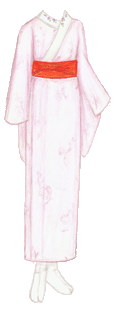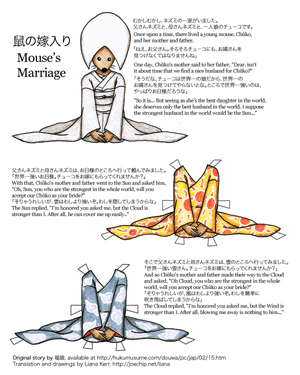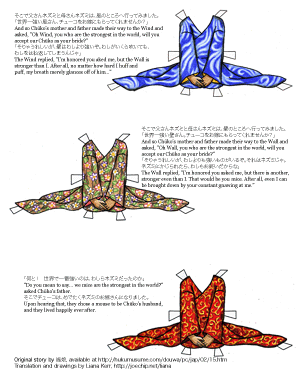As I wrote earlier, I finally bought Flash (all the while cursing my stupidity for not having thought to buy it while I was in grad school). There is an incredible amount of things I don’t know yet, but I’ve just started getting through the book I bought to go with it, to say nothing of whatever tutorials are out there. I borrowed little Chūko for help with my first Flash exercise – as you’ll see within a couple of minutes of playing with it, there are a couple of things I especially need to figure out like having clothes snap to the doll and making it so the white space isn’t selectable. I’ll get there, though.
If you know of any particularly good Flash dress-up games or dress-up game makers, please post a comment! I particularly like some of the ones on Doll Divine, but mostly I am interested in ones with really good interfaces.
I do intend to draw a proper outfit for today, don’t worry. (Hi, Mom.)
The Mars Person Visits Earth, circa 2001
I’m sorry I didn’t post yesterday – I kind of got carried away with another project. However, I do have some good news! I bought Flash CS5. I learned to use Flash (to some extent) in college, but haven’t touched it for a long time. But it’s something I always wanted to learn to do again, for what should be obvious reasons.
This is a dress-up game I did in college for my boyfriend (now husband). If you are observant, you may have seen the Mars Person elsewhere on joechip.net. If you’re very observant, you may have seen him twice. I should note that “pop culture references” doesn’t work. Whether this was because I never got around to it, or a deliberate joke because I was then, as I am now, rather out of touch with pop culture, I couldn’t tell you. But it is more likely that it has to do with my laziness.
Kimono Basics #1: Pink Naga-juban with Red Date-jime
 Click for larger version (PNG); click for PDF version. Click here for the list of dolls.
Click for larger version (PNG); click for PDF version. Click here for the list of dolls.
I was once asked why I never drew Japanese clothes, and the answer was simple: not only do I not know enough about them, but I know I don’t know enough about them. If I was a Civil War historian or a Marie Antoinette fangirl, it would probably bug me to draw inaccurate clothing from those time periods, but I’m not, so I do my best based on historical sources, and if the general shape and decoration are plausible, it’s fine with me if the colors aren’t quite right. However, I studied Japanese literature and culture in college, and I still study the Japanese language off and on even now, so if I drew Japanese clothes with imperfect understanding, it would really bother me. I had picked up a book on kimono in college, but had only skimmed everything about the history of kimono and modern-day kimono because the part I was interested in was clothing from around 800-1000 A.D., as I was studying Heian-era literature. But I did manage to pick up that modern kimono were bound by rules and the patterns, colors and way of wearing them were all laden with significance.
At the same time, I wasn’t all that interested in Japanese clothes: as you might have guessed, I like crazy full skirts, ruffles, interesting things to shade and varying silhouettes: kind of the opposite of the kimono in every way. Kimono just seemed boxy, prim and plain to me. Plus, I didn’t understand the underlying color sense: for example, what makes a particular obi go with a particular kimono? I’m well aware that what seems aesthetically pleasing to me is in large part influenced by my cultural background, and if I looked at a kimono I just felt like I didn’t even know how to start understanding it, much less draw one on my own.
This was around spring of 2010, and since then, I’ve been educating myself about kimono. My primary English source was the excellent Kimono: Fashioning Culture, which answered most of my questions, but I’ve also been reading other books such as The Book of Kimono and Japanese Costume and Textile Arts, I picked up a Japanese book, 家じゅうの着つけと帯結び (Wearing Kimono and Tying Obi for the Whole Family) which makes a lot of this information much less abstract, and I’ve spent a lot of time looking at online stores, magazines and reading things such as The Kimono Lady, Japan Now and Then and the Immortal Geisha forums, where English-speaking kimono enthusiasts post pictures of themselves in kimonos, the latest accessories they’ve bought or made and questions about everything related to kimono. I love and appreciate kimono, now, and although I expect to make a great many mistakes I’m ready to start drawing them. I want to explore kimono colors, patterns, history and so on through my paperdolls, and I hope you all enjoy it too.
Before we get into all that, we’ll start with the most basic of basics. The kimono (着物、きもの) is an ankle-length robe with a lapped front and long sleeves, worn with a wide, stiff sash called an obi (帯、おび). Historically, for America and Europe, “fashion” has meant the way the shapes of garments changed: think of the differences between 1860s hoop skirts, 1890s bustles and 1920s flapper dresses. In Japan, the basic shape of the kimono has changed very little since it was adapted from China, especially since Western clothes became popular for daily wear, and it is color and pattern that really show a garment’s age, worth and purpose. Originally, the kimono was called a kosode (小袖、こそで, meaning small sleeve), and it was white and worn under pants and other robes; as time went on, it was freed from these other layers and became elaborately decorated. In the same way, the obi was once just a regular fabric sash, but it widened to balance out the kimono and often became more expensive than the kimono itself. Modern-day kimono are mainly worn by women as a formal garment, and the way the kimono is cut, worn, colored and patterned indicates things like the wearer’s age, the season and the occasion.
I’ve gone with the most basic of basics for today’s drawing, too: kimono underwear! First, you put on the white split-toed socks called tabi (足袋、たび), because after you’re wearing the full kimono, it’s hard to bend over enough to put them on. Next, you wear a kimono bra (和装ブラジャー, わそうブラジャー), which looks like a sports bra and flattens the chest, and over that a short-sleeved overshirt called a hada-juban (肌襦袢、はだじゅばん) and a wrap skirt that ends about below the calves called a susoyoke (すそよけ), which mainly serve to trap sweat. It looks like you can also get a single garment that combines those last two, as well, although my book doesn’t have a picture of it. The ideal body shape for wearing kimono for a formal occasion is basically cylindrical, so at this point, you might use a towel or other fabric to pad out areas such as your waist or shoulders.
Over all this goes the naga-juban (長襦袢、ながじゅばん), which is just a little shorter than the actual kimono but otherwise has the same shape. The neckband of the naga-juban is covered by a collar called a han-eri (半襟、はんえり), which is sewn on to prevent the neckband of the naga-juban from getting dirty and can be easily replaced. The han-eri and the inside of the wrists of the naga-juban are the only parts of the underwear that show when the kimono is worn. Generally, and particularly for formal kimono, the han-eri is pure white, but there are also colored and embroidered han-eri. The naga-juban is secured around the waist with a thin sash called a koshi-himo (腰紐、こしひも), then a date-jime (伊達締め、だてじめ), a wider sash, is tied around the waist again. This is because when you put on the naga-juban, you determine where the back of the neckband will be. It isn’t worn right on the neck like you would wear a robe: it’s supposed to show the nape of the neck a bit, but not too much. The purpose of the date-jime is to keep the neckband in place.
At this point, you’re ready to put on the kimono itself! At some point, we’ll look at what the shape of the kimono can tell you.
This is a naga-juban and date-jime based on the pictures from Wearing Kimono and Obi Tying for the Whole Family, which was also the source of my information about kimono underwear. (I couldn’t resist adding some embroidery around the collar, though.) Most of the historical information is from Kimono: Fashioning Culture.
Mouse’s Marriage (ネズミの嫁入り) and my New Year’s resolution

 Click for larger version (PNG):page 1, page 2; click for PDF version: page 1, page 2. Click here for the list of dolls.
Click for larger version (PNG):page 1, page 2; click for PDF version: page 1, page 2. Click here for the list of dolls.
I drew this for my mom for Christmas, and she gave me permission to post it. I hope you all like it as much as she did! I’m still learning the ins and outs of kimono drawing, so please forgive any inaccuracies. The original Japanese story can be read here: ネズミの嫁入り (Mouse’s Marriage). I’ve been in contact with the maintainer of that site, actually, and she’s given me permission to translate the other stories there, so I plan to do a lot of those in 2011.
Speaking of 2011… Sometimes, people will e-mail me and ask how to draw dolls, and the advice I give is essentially just to keep practicing, using resources like SenshiStock and library books on figure drawing. That makes me feel like a fraud, because I myself am lousy at drawing humans, and it really shows in my dolls. (I’m happy with Ivy for now, but drawing her took days.) I look at the work of some of my internet buddies like Lys, who does this great daily fashion journal and Boots, who draws dolls in really natural, comfortable poses, and I think, wow, if I could draw dynamic poses like that, or if I could draw great faces like that, or if my hands had that much expression… But then, to borrow a phrase from Jane Austen, I have always supposed it to be my own fault—because I will not take the trouble of practicing.
I don’t have a great track record with New Year’s resolutions, and I believe last year I had none at all (which, really, I rather enjoyed). But I’m going to try one this year. I resolve to spend 20 minutes each day – or, perhaps, each day I can, let us not raise the bar too high now – sketching people. I know this is one I can do, because actually I have already been doing it off and on for a few weeks now.
Two questions for you all. First, would you like me to post the results of my progress? It might help keep me on the straight and narrow to just scan my sketches and link to them at the end of posts, but I can’t imagine it would be very interesting. (Plus, the idea is slightly frightening – I do these sketches of hands that look more like dead sea anemones, and my pride tells me “better hide those, Liana.”) Second, since I’ll just be using freely available reference and stock images and possibly a book or two from the library, would anyone like to adopt my resolution and join me? I was thinking, if there’s interest from a couple other people, we might set up some sort of blog or forum, pick out the day’s pose, share our sketches and keep each other motivated. It’s just a thought, but if you’re interested, whatever your skill level is, e-mail me or post a comment.
My next post will be on the 4th. Happy New Year!
 Share
Share